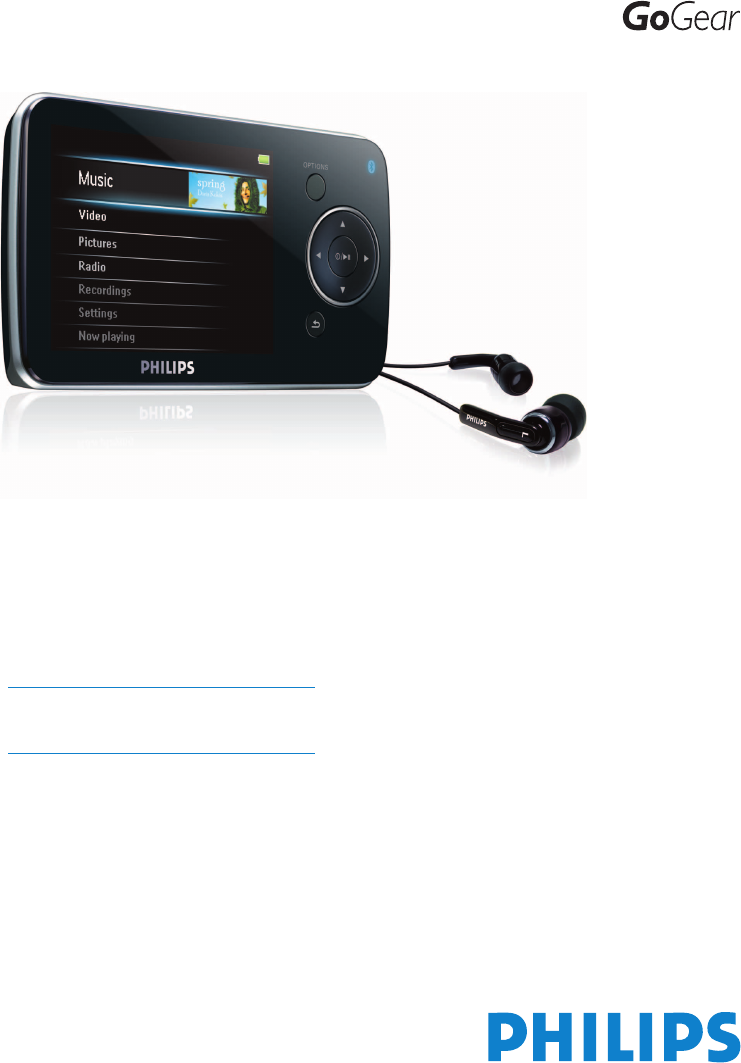Philips Consumer Lifestyle SA5225BT Digital Audio Player User Manual SA52xx English
Philips Consumer Lifestyle Digital Audio Player SA52xx English
manual

3
1 Important safety information 5
2 Your new player 10
2.1 What’s in the box 10
2.2 Register your product 10
3 Getting started 11
3.1 Overview of controls and connections 11
3.2 Main menu 12
3.3 Install 12
3.4 Connect and charge 13
3.4.1 Use the supplied USB cable 13
3.4.2 Battery level indication 13
3.5 Transfer music and pictures 14
3.6 Transfer videos 14
3.7 Enjoy 15
3.7.1 Turn on and off 15
3.7.2 Navigate the menu 16
3.7.3 Connect Bluetooth headphones (or other Bluetooth devices) 16
3.7.4 Lock slider 16
4 Organize and transfer music and pictures with
Rhapsody Media Player 17
4.1 Install Rhapsody Media Player 17
4.1.1 View subscription status 17
4.2 Add Rhapsody Music2 to the player 17
4.3 Add Rhapsody Music Channels3 to the player 18
4.4 Transfer picture files to the player with Rhapsody Media
Player 18
5 Detail operation 19
5.1 Music mode 19
5.1.1 Control 19
5.1.2 Find your music 20
5.1.3 Find your Rhapsody4 channels 21
5.1.4 Rating the songs in your Rhapsody3 channels 21
5.1.5 Adding music from your Rhapsody3 channels to the player library 21
5.1.6 Limit the volume 21
5.1.7 Resume play (Now playing) 22
5.2 Picture library 23
5.2.1 View pictures 23
5.2.2 Adding pictures to folder ‘Favorites’ 23
5.2.3 Slideshow 23
Contents

4
5.3 Listen to audio books 24
5.3.1 Select audio book by book title 24
5.3.2 Select audio book by author 24
5.3.3 Audiobook controls 24
5.3.4 Adjust audiobook play speed 25
5.3.5 Add a bookmark in an audiobook 25
5.3.6 Find a bookmark in an audiobook 25
5.3.7 Delete a bookmark in an audiobook 25
5.3.8 Delete an audiobook 26
5.4 Video 27
5.4.1 Transfer videos from a computer to the player 27
5.4.2 Video play 27
5.4.3 Fast forward / backward control 27
5.5 Radio 28
5.5.1 Automatic tuning of radio stations 28
5.5.2 Play a preset radio station 28
5.5.3 Manually tune a radio station 28
5.5.4 Manually save a radio station to a preset 29
5.5.5 Record from FM radio when the radio is playing 29
5.6 Recordings 30
5.6.1 Play recordings 30
5.6.2 Delete recordings 30
5.6.3 Upload recordings to the computer 31
5.7 Use your player to store and carry data files 31
6 Play and transfer music, videos, or audiobooks
with Bluetooth 32
6.1 Play audio or video, or audiobooks on another Bluetooth
output device 32
6.2 Transfer files to and from another Bluetooth device 33
6.2.1 Transfer files from a list 33
6.2.2 Transfer files while playing 34
6.2.3 Receive files 35
7 Settings 36
7.1 Equalizer custom settings 37
8 Update your player 38
8.1 Perform a software update 38
9 Technical data 39
10 Frequently asked questions 41
Contents

5
1 Important safety information
General maintenance
To avoid damage or malfunction:
• Do not expose the player to excessive heat caused by heating equipment or direct
sunlight.
• Do not drop your player or allow objects to fall on your player.
• Do not allow your player to be submerged in water. Do not expose headphone socket or
battery compartment to water, as water entering the set may cause major damage.
• Do not use any cleaning agents containing alcohol, ammonia, benzene, or abrasives as
these may harm the set.
• Active mobile phones in the vicinity may cause interference.
• Back up your files. Please ensure that you retain the original files you have downloaded to
your device. Philips is not responsible for any loss of data if the product becomes damaged
or not readable / legible.
• Manage (transfer, delete, etc.) your music files only with the supplied music software to
avoid problems!
About operating and storage temperatures
•Operate in a place where temperature is always between 0 and 35ºC (32 to 95ºF)
•Store in a place where temperature is always between -20 and 45ºC (-4 to 113ºF)
•Battery life may be shortened in low temperature conditions.
Replacement parts/accessories
Visit www.philips.com/support to order replacement parts/accessories.
Hearing Safety
Listen at a moderate volume.
• Using headphones at a high volume can impair your hearing. This product can
produce sounds in decibel ranges that may cause hearing loss for a normal person,
even for exposure less than a minute. The higher decibel ranges are offered for
those that may have already experienced some hearing loss.
• Sound can be deceiving. Over time your hearing “comfort level” adapts to higher volumes
of sound. So after prolonged listening, what sounds “normal” can actually be loud and
harmful to your hearing. To guard against this, set your volume to a safe level before your
hearing adapts and leave it there.
To establish a safe volume level:
• Set your volume control at a low setting.
• Slowly increase the sound until you can hear it comfortably and clearly, without distortion.
Listen for reasonable periods of time:
• Prolonged exposure to sound, even at normally “safe” levels, can also cause hearing loss.
• Be sure to use your equipment reasonably and take appropriate breaks.

6
Be sure to observe the following guidelines when using your headphones.
• Listen at reasonable volumes for reasonable periods of time.
• Be careful not to adjust the volume as your hearing adapts.
• Do not turn up the volume so high that you can’t hear what’s around you.
• You should use caution or temporarily discontinue use in potentially hazardous situations.
• Do not use headphones while operating a motorized vehicle, cycling, skateboarding, etc.; it
may create a traffic hazard and is illegal in many areas.
Important (for models supplied with headphones):
Philips guarantees compliance with the maximum sound power of its audio players as
determined by relevant regulatory bodies only with the original model of provided
headphones. In case this one needs replacement, we recommend that you contact your
retailer to order a model identical to that of the original, provided by Philips.
Copyright information
All other brands and product names are trademarks of their respective companies or
organizations.
Unauthorized duplication of any recordings whether downloaded from the Internet or made
from audio CDs is a violation of copyright laws and international treaties.
The making of unauthorized copies of copy-protected material, including computer
programmes, files, broadcasts and sound recordings, may be an infringement of copyrights
and constitute a criminal offence. This equipment should not be used for such purposes.
This product is protected by certain intellectual property rights of Microsoft Corporation.
Use or distribution of such technology outside of this product is prohibited without a license
from Microsoft or an authorized Microsoft subsidiary.
Content providers are using the digital rights management technology for Windows Media
contained in this device (“WM-DRM”) to protect the integrity of their content (“Secure
Content”) so that their intellectual property, including copyright, in such content is not
misappropriated. This device uses WM-DRM software to play Secure Content (“WM-DRM
Software”). If the security of the WM-DRM Software in this device has been compromised,
Microsoft may revoke (either on its own or upon the request of the owners of Secure Content
(“Secure Content Owners”)) the WM-DRM Software’s right to acquire new licenses to copy,
display and/or play Secure Content. Revocation may also prevent your device’s ability to
transfer, store, copy, display and/or play Secure Content which you have previously stored on
your Device. Revocation does not alter the WM-DRM Software’s ability to play unprotected
content. A list of revoked WM-DRM Software is sent to your device whenever you download
a license for Secure Content from the Internet or from a PC. Microsoft may, in conjunction
with such license, also download revocation lists onto your device on behalf of Secure Content
Owners, which may disable your device’s ability to copy, display and/or play Secure Content.

7
In the event of revocation, Philips will attempt to make available software updates to restore
some or all of your device’s ability to transfer, store, access, copy, display and/or play Secure
Content. However, the ability to make such updates available does not rest solely with
Philips. Philips does not guarantee that, after revocation, such software updates will be
available. If such updates are not available, your device will not have the ability to transfer,
store, copy, display and/or play Secure Content - even Secure Content which you have
previously stored on your device.
In addition, even if such software updates are available, they may not enable your Device to
transfer, store, copy, display, and/or play Secure Content which was previously stored on
your Device. In some cases you may be able to transfer the content from the PC. In other
cases, you may have to repurchase previously obtained Secure Content.
To summarize - Microsoft, Secure Content Owners, and Secure Content distributors may
deny you access, or restrict your access, to Secure Content. They may also disable your
device’s ability to transfer, store, copy, display and/or play Secure Content even after you
have paid for and obtained it. Neither your consent nor the consent or approval of Philips is
necessary for any of them to deny, withhold or otherwise restrict your access to Secure
Content or to disable your device’s ability to transfer, store, access, copy, display, and/or play
Secure Content. Philips does not guaranty that you will be able to transfer, store, access,
copy, display, and/or play Secure Content.
The Windows Media and the Windows logo are registered trademarks of Microsoft
Corporation in the United States and/or other countries.
Data logging
Philips is committed to improving the quality of your product and enhancing the Philips user
experience. To understand the usage profile of this device, this device logs some info / data
to the non-volatile memory region of the device. These data are used to identify and detect
any failures or problems you as a user may experience while using the device. The data
stored, for example, will be the duration of playback in music mode, duration of playback in
turner mode, how many times battery low was encountered, etc. The data stored do not
reveal the content or media used on the device or the source of downloads. The data stored
on the device are retrieved and used ONLY if the user returns the device to the Philips
service centre and ONLY to simplify error detection and prevention. The data stored shall
be made available to user on user’s first request.

8
Disposal of your old product
Your product is designed and manufactured with high quality materials and
components, which can be recycled and reused.
When this crossed-out wheeled bin symbol is attached to a product, it means the
product is covered by the European Directive 2002/96/EC.
Please be informed about the local separate collection system for electrical and electronic
products.
Please act according to your local rules and do not dispose of your old product with your
normal household waste. The correct disposal of your old product will help prevent potential
negative consequences to the environment and human health.
The build-in rechargeable battery contains substances that may pollute the environment.
Always hand the appliance in at an official collection point to remove the battery before
discarding the appliance. Battery should be disposed of at an official collection point.
Modifications
Modifications not authorized by the manufacturer may void user authority to operate this
device.

9
Notice for USA
Note:
This equipment has been tested and found to comply with the limits
for a Class B digital device, pursuant to part 15 of the FCC Rules.
These limits are designed to provide reasonable protection against
harmful interference in a residential installation. This equipment
generates, uses, and can radiate radio frequency energy and, if not installed and used in
accordance with the instruction manual, may cause harmful interference to radio
communications.
However, there is no guarantee that interference will not occur in a particular installation. If
this equipment does cause harmful interference to radio or television reception, which can
be determined by turning the equipment off and on, the user is encouraged to try to correct
the interference by one or more of the following measures:
- Relocate the receiving antenna.
- Increase the separation between equipment and receiver.
- Connect the equipment into an outlet on a circuit different from that to which the
receiver is connected.
- Consult the dealer or an experienced radio/TV technician for help.
Notice for Canada
This Class B digital apparatus complies with Canadian ICES-003.
The set complies with the FCC-Rules, Part 15 and with 21 CFR 1040.10. Operation is subject
to the following two conditions:
• This device may not cause harmful interference, and
• This device must accept any interference received, including interference that may cause
undesired operation.
Notice for the European Union
This product complies with the radio interference requirements of the European Union.
Philips
SA5225 SA5225BT
SA5245 SA5245BT
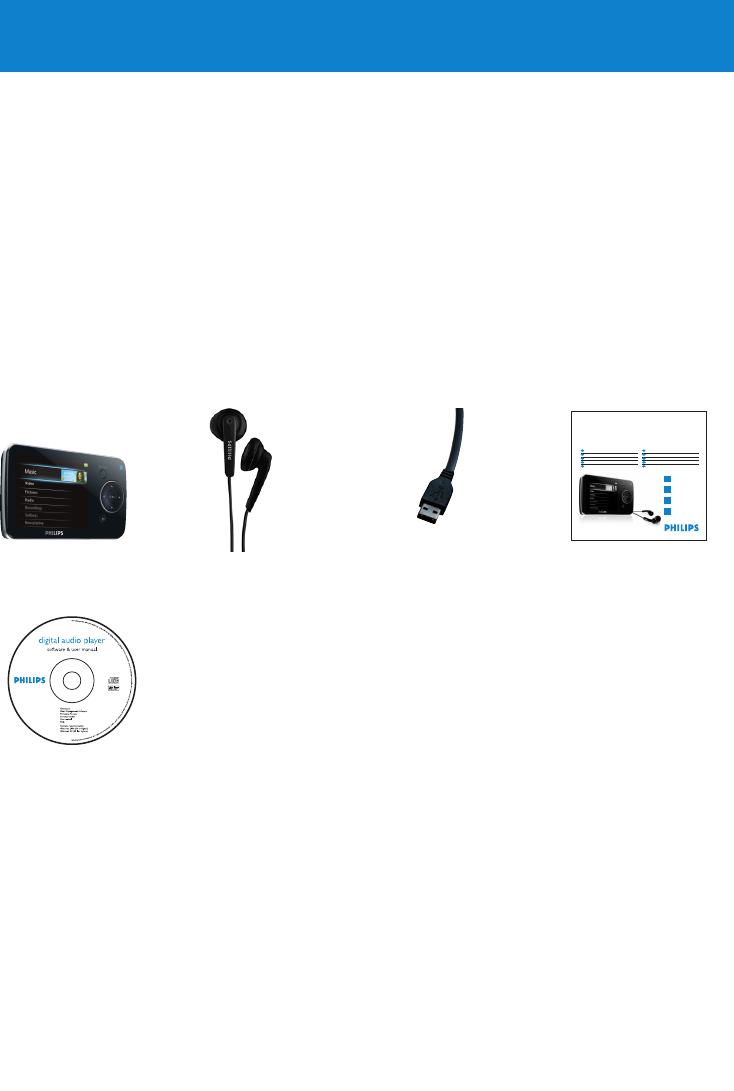
10
2 Your new player
With your newly purchased player, you can enjoy the following:
• Stream audio and transfer files using Bluetooth®
• Play video files (WMV, MPEG4 (.avi))
• Play audio files (WMA, AAC (unprotected))
• Display album art
• View pictures
• Listen to audio books
• Listen to FM radio
• Record FM radio1 and voices / sounds
• View folders
2.1 What’s in the box
The following accessories are included with your player:
2.2 Register your product
We strongly recommend that you register your product in order to gain access to free
updates. To register your product, please log on to www.philips.com/welcome so that we
can inform you as soon as new updates become available.
USB cable Quick start guide
CD-ROM containing Philips Device Manager, Philips Media
Converter, User Manual and Frequently Asked Questions
HeadphonesPlayer
Philips GoGear audio player
1
2
3
4
Install
Connect
and charge
Transfer
Enjoy
Quick start guide
Quick start guide 1
Guide de démarrage rapide 11
Guía de inicio rápido 21
Kurzbedienungsanleitung 31
Handleiding voor snel gebruik 41
Guida di riferimento rapido 51
Snabbstartsinstruktioner 61
Быстрый запуск 71
Przewodni szybkiego startu 81
91
Hızlı Başlama Kılavuzu
IT
SV
RU
PL
TR
EN
FR
ES
DE
NL
SA5225 SA5225BT
SA5245 SA5245BT
SA5285 SA5285BT
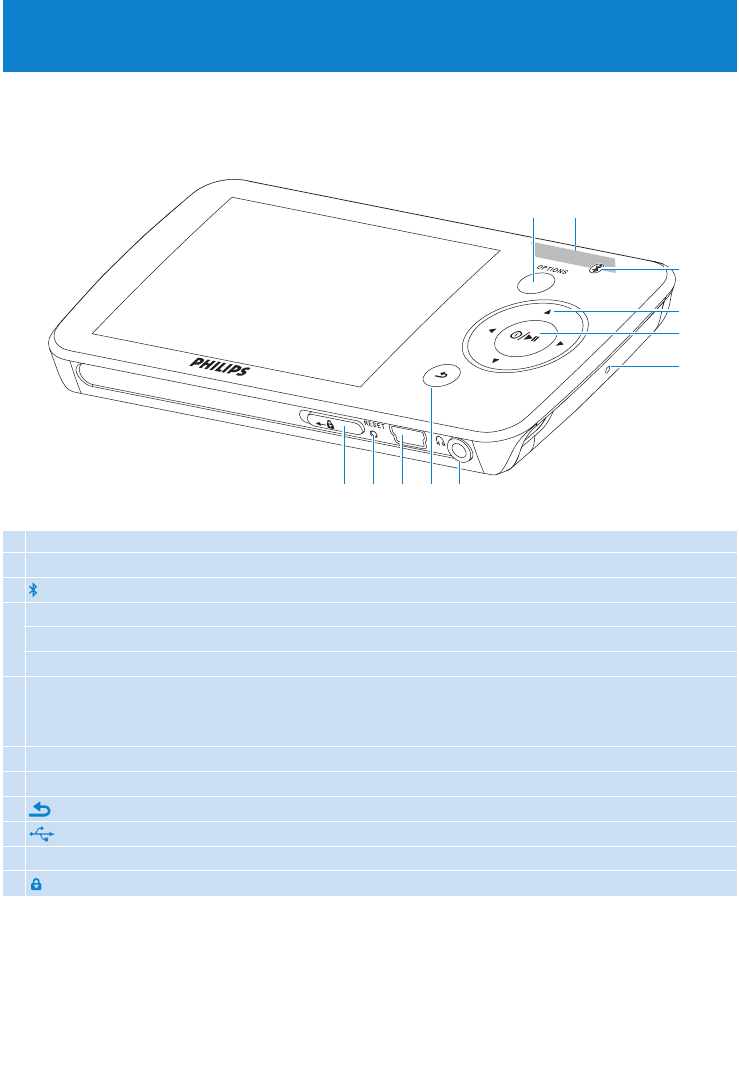
11
AOPTIONS Offers a selection of options, depending on the current menu
B-VOLUME+ Increases/decreases volume (hold to increase/decreases fast)
CBluetooth indicator
D1Skips back (hold to quick skip)
2Skips forward (hold to quick skip)
3/4Scrolls up/down (hold to quick scroll)
Ez/ 2; On / Off
Play/Record / Pause
Confirm selection
FMIC Microphone
GpHeadphones jack
HBack one level (hold to return to root menu)
IUSB connector
GRESET
Hslider Hold slider to lock/unlock all keys (except -VOLUME+)
3 Getting started
3.1 Overview of controls and connections
I
E
F
GJK H
C
A B
D

12
3.3 Install
Important Make sure to install the software provided in the supplied CD for music
and video transfer.
System requirements:
• Windows 2000, XP or Vista
• Pentium III 800MHz processor or higher
• 128MB RAM
• 500MB hard disk space
• Internet connection
• Microsoft Internet Explorer 6.0 or later
• CD-ROM
• USB port
Important You need Windows XP Service Pack 2 to install and run this software. In
case you do not have this on your PC, you will be asked to install the Service Pack. Please do
install this, complete the rest of your software installation and only then connect your device.
This is critical to ensure the proper working of your player when connected to the PC.
1Insert the CD supplied with your product into the CD ROM drive of your PC.
22. Follow the on-screen instructions to complete the installation of Rhapsody Media
Player, Philips Device Manager and Philips Media Converter. The Philips Media
Converter converts video clips and JPEG pictures into suitable formats for the player.
3If the installation program does not start automatically, browse the CD contents with
Windows Explorer and double click on the file ending with .exe.
Lost your CD? Don’t worry, you can download the CD contents from
www.philips.com/support.
Menu To
Music Play digital music tracks
Rhapsody Demo Try out Rhapsody services
Rhapsody* Listen to Rhapsody Music Channels
Video Watch videos
Pictures View pictures
Radio Listen to or record from FM radio1
Recording Create or listen to recordings
Folders View folders2
Settings Customize the settings of your player
Now playing Go to the play screen
Last played Resume play
3.2 Main menu
* Only available after active Rhapsody Music Channel content is transferred to the player.
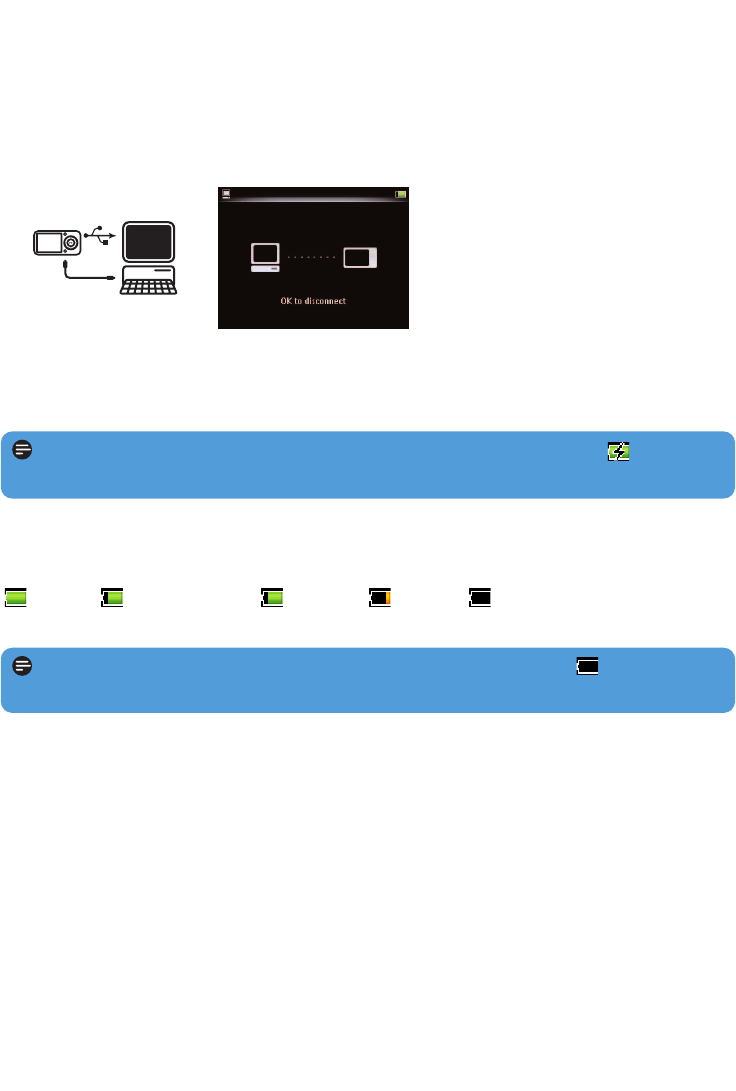
13
3.4.2 Battery level indication
The approximate power levels of your battery are indicated as follows:
Full Two-thirds full Half full Low Empty
1Rechargeable batteries have a limited number of charge cycles. Battery life and number of
charge cycles vary by use and settings.
3.4 Connect and charge
When you connect the player to the PC, it automatically charges.
3.4.1 Use the supplied USB cable
1Before you use the player for the first time, charge it for at least 5 hours.
> The battery2has a 100% charge after 4 hours and an 80% charge after 2 hours.
2Connect the supplied USB cable to the mini USB port at the bottom of the player, the
other end to your PC.
> The player will start to charge as soon as it is connected to your PC.
Note The player is fully charged when the charging animation stops and is
displayed. Your fully charged player will allow up to 30 hours1of music playback.
Note When the batteries are almost empty, the low battery screen blinks. The
player saves all settings and unfinished recordings and switches off in less than 60 seconds.
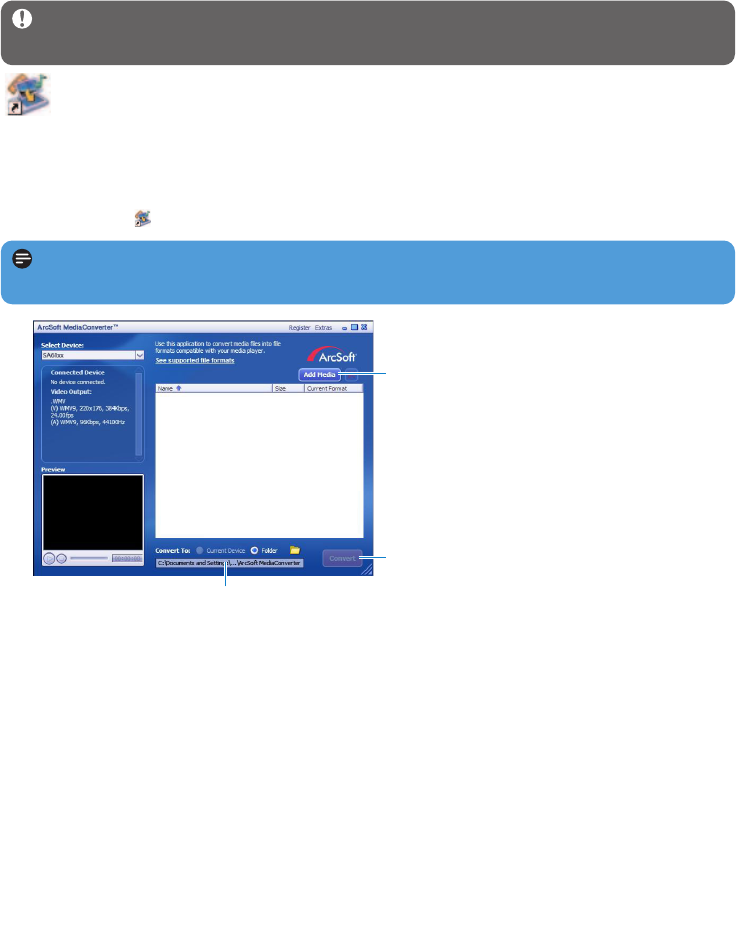
14
Note Video conversion and transfer is usually a long process and dependent on your PC
configuration.
3.5 Transfer music and pictures
You can transfer music and picture files to your player using Rhapsody Media Player. See
Organize and transfer pictures and music with Rhapsody Media Player section of this user
manual for more details.
3.6 Transfer videos
Important Play DRM protected videos once in Windows Media Player on your PC,
before you transfer them with MediaConverter for Philips.
Use MediaConverter for Philips to convert the video files to the correct screen
size and transfer videos from your PC to your player. This application will convert
your video files to the right format and resolution before transferring them to your player so
that they are guaranteed to playback on your player without any problems.
1Use the supplied USB cable to connect your player to the PC.
2Click on the icon on your desktop, to start the MediaConverter for Philips.
> All the converted files are transferred to the player.
3In the option Convert to: at the bottom of the screen, select Current Device.
4Press the Add Media button and locate the files on the PC.
5Click OPEN to add the selected file.
You can add multiple files.
6Press Convert.
> All the converted files will be transferred to the player.
6
4
3
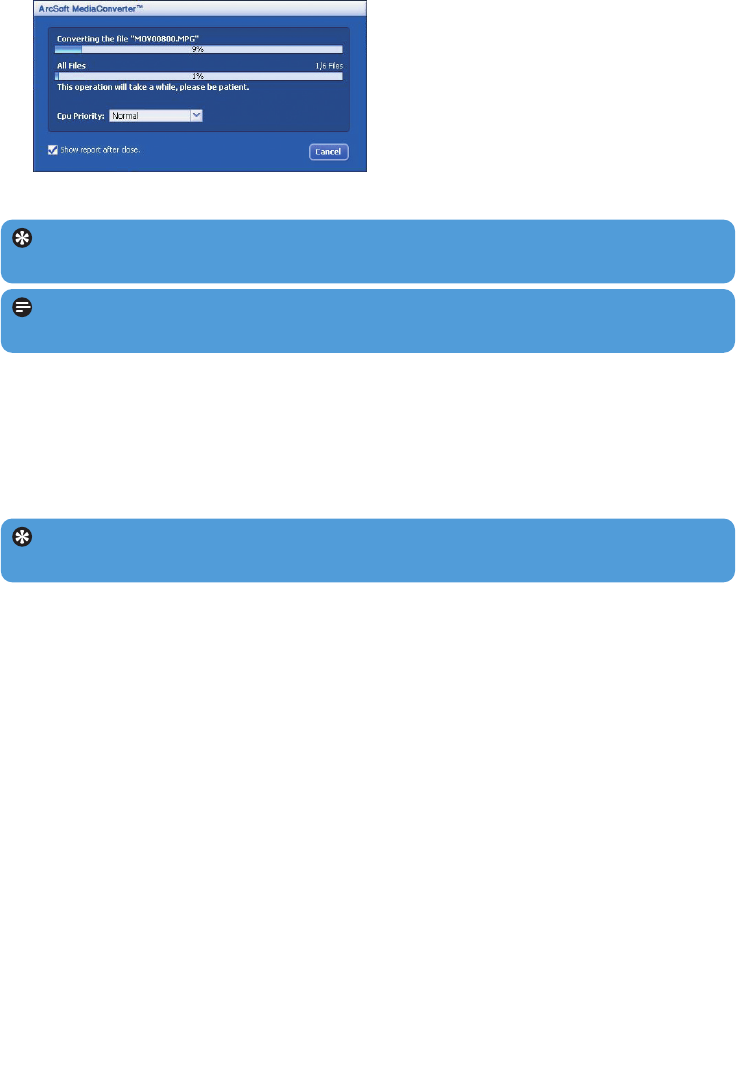
15
Tip You can also select the files in Windows Explorer and then drag and drop them
into the MediaConverter for Philips screen.
Note If needed, the files will first be converted to a format that can be played on the
player.
Tip If the player is in stop mode and no button is pressed for 10 minutes, it switches
off automatically.
> The progress of conversion and transfer is shown.
3.7 Enjoy
3.7.1 Turn on and off
To turn on, press z/2; until the display shows the Philips logo.
To turn off, press and hold z/2; until the display shows ‘Bye’.
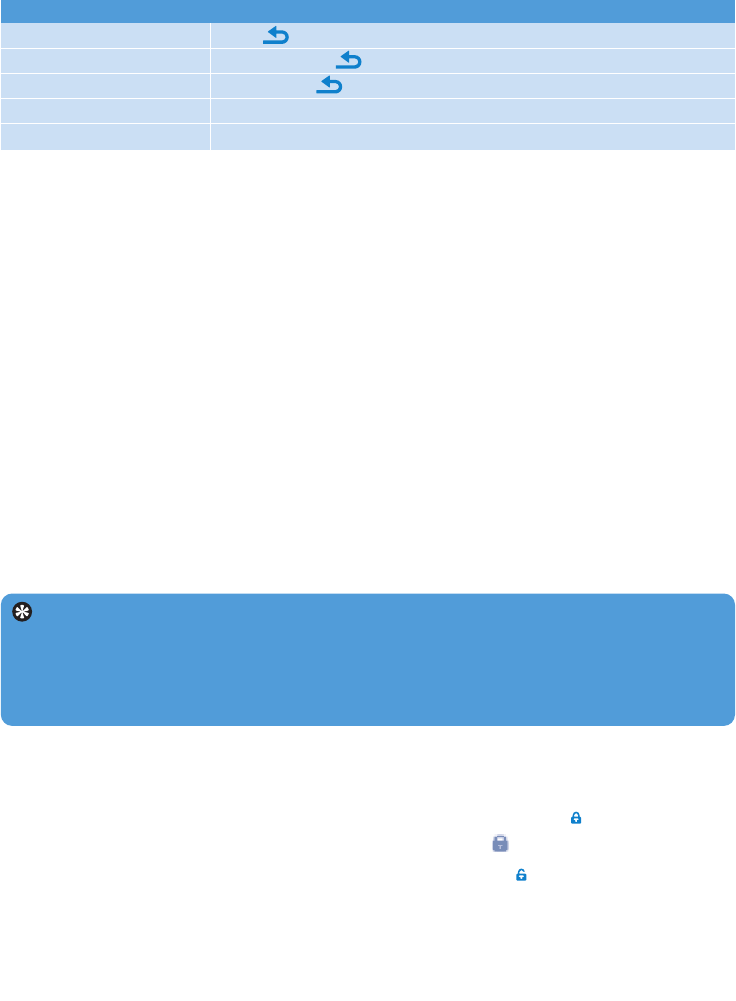
16
Goal Action
Return to previous menu Press
Return to main menu Press and hold
Browse through menus Press 2; or
Scroll through a list Press 3or 4
Select an option Press 2;
3.7.4 Lock slider
The player has a lock switch to prevent any accidental operation.
1To lock the buttons when you play, move the lock slider to position .
> All buttons except -VOL+ are locked and the display shows .
2To unlock the buttons again, move the lock slider to position
3.7.3 Connect Bluetooth headphones (or other Bluetooth devices)
You can connect any kind of Bluetooth headphones as well as home or car audio systems.
The following steps explain how to connect the player to a new device:
1On the Home menu, select Settings.
2Press the OPTIONS key.
3Press 3or 4and 2; to select the option Bluetooth.
4Select Bluetooth On to activate the Bluetooth feature of the player.
5Press 3or 4and 2; to select Connect to°K.
> The list shows option New Device as well as already paired devices.
6Press 3or 4and 2; to select New Device.
> The player searches and then displays the list of found devices.
7Select the device you want to connect to.
8Enter the passkey of the other device if necessary.
> A confirmation message appears upon successful connection.
3.7.2 Navigate the menu
Your player has an intuitive menu navigation system to guide you through various settings
and operations.
Tip
You can also connect to a Bluetooth device and transfer music while playing music: Refer
to chapter Play and transfer music or videos with Bluetooth.
When you tick the box Show Device to Others in the Bluetooth settings menu, you
make the player discoverable to other Bluetooth devices.

17
4.2 Add Rhapsody Music2to the player
Depending on the type of Rhapsody account you hold, you can add Rhapsody Music to the
player using. For more information visit www.Rhapsody.com.
1Connect the player to the computer.
2Launch the Rhapsody Media Player.
3In the Sources window on the left hand side of the screen, select the tab Rhapsody
Music Guide.
4In the main window, click on the +icon to add a title to My Library.
5In the Sources window, select My Library.
6From the main window, drag and drop your channels to the player in the Sources window.
Tip You can also check the status of your Rhapsody account on the Internet at
www.Rhapsody.com.
4 Organize and transfer music and
pictures with Rhapsody Media
Player
4.1 Install Rhapsody Media Player
Install the Rhapsody Media Player from the supplied software CD. (See section 3.3 Install
for more details).
4.1.1 View subscription status
You can view your Rhapsody subscription status at the bottom of the display, next to the
battery level indicator:
Currently licensed Rhapsody account
Rhapsody account subscription expires in 7 days
Rhapsody account subscription expires in 2 days
No Rhapsody account subscription (or subscription is invalid / expired)
2This feature is available only for music that you purchased through Rhapsody.

18
4.3 Add Rhapsody Music Channels3to the player
Depending on the type of Rhapsody account you hold, you can add Rhapsody Music Channels
to the player using. For more information visit www.Rhapsody.com
1Connect the player to the computer.
2Launch the Rhapsody Media Player.
> The player is shown in the Sources window on the left hand side of the screen.
3In the Sources window, select the tab Channel Guide.
4In the main window, click on the +icon to add a channel to My Channels.
5In the Sources window, select My Channels.
6Drag and drop your channels to the player in the Sources window.
4.4 Transfer picture files to the player with
Rhapsody Media Player
You can transfer picture files to your player using Rhapsody Media Player.
1Connect the player to the computer.
2Launch the Rhapsody Media Player.
> The player is shown in the Sources window on the left hand side of the screen.
3In the Sources window, select My Library.
4In the main window, click on a tab to select Photos.
5Click on the Add Photos icon.
6In the Add Media to My Library pop-up window, select the source you want to
browse for media files.
7Click Import.
8Drag and drop the files from the main window to the player in the Sources window.
3This feature is available only if you subscribe to Rhapsody Music Channels.
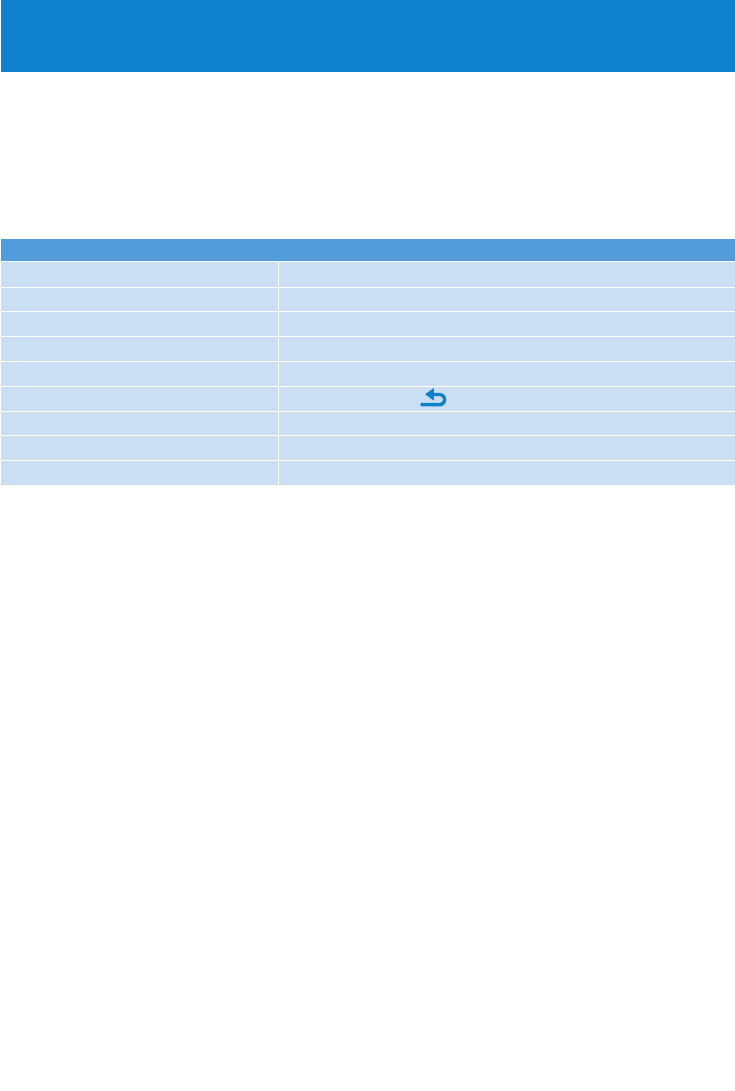
19
5 Detail operation
5.1 Music mode (also play mode for recordings)
Your player supports MP3 and WMA formats.
5.1.1 Control
The player offers the following music mode options:
Goal Action
Play / Pause music Press 2;
Skip to next audio file Press 2
Return to previous audio file Press 1
Fast forward Press and hold 2
Fast rewind Press and hold 1
Return to browsing menu Long/short press
Increase volume Press VOL +
Decrease volume Press VOL -
Access options menu Press OPTIONS
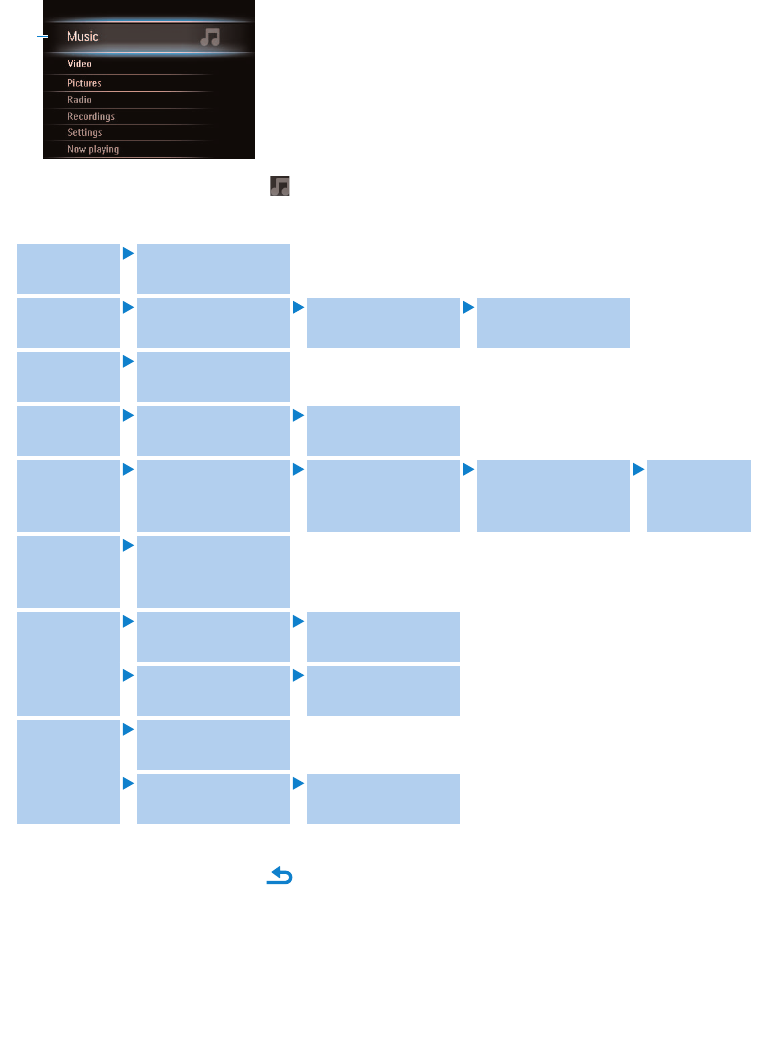
20
2Press 3or 4to scroll through the list.
3Press 2; to select or press to return to previous level.
4Press 2; to play.
5.1.2 Find your music
1From the main menu, select to enter music mode.
The player offers the following menu options:
1
All songs Alphabetically
listed tracks
Artists Alphabetically
listed artists
Alphabetically
listed albums
Tracks listed in
album order
Album art Alphanumerically
listed album art
Albums Alphanumerically
listed albums
Tracks listed in
album order
Genres Alphanumerically
listed genres
Alphanumerically
listed artists
Alphanumerically
listed albums
Tracks
listed in
album order
Rating4Tracks listed in
descending order
of rating
Playlists Numerically listed
'Playlists on the go'
Tracks listed in
play order
Alphanumerically
listed playlists
Tracks listed in
play order
Audiobooks Alphanumerically
listed book titles
Alphanumerically
listed authors
Alphanumerically
listed book titles
4This feature is only available for some versions.
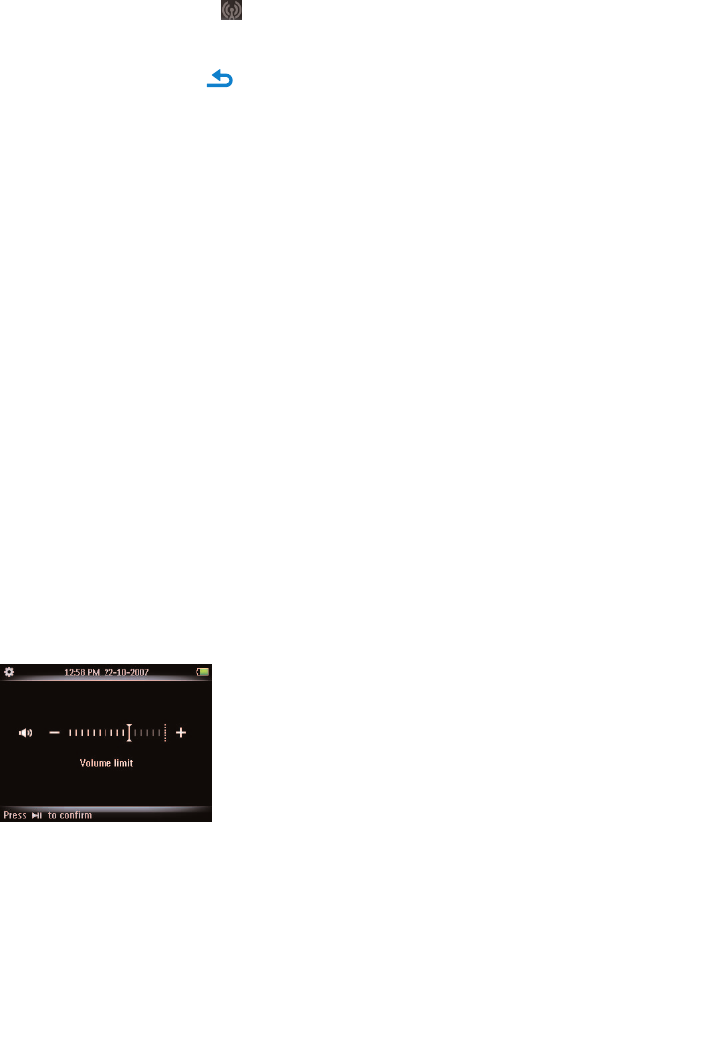
5Rhapsody mode is available only if you hold an active Rhapsody account. (See section Organize
and transfer music and pictures using Rhapsody Media Player in this user manual for
more information.) 21
5.1.3 Find your Rhapsody4channels
1From the main menu, select to enter Rhapsody mode.
2Press 3or 4to scroll through the list of items that are available to you.
3Press 2to select or press to return to previous level.
4Press 2; to play.
5.1.4 Rating the songs in your Rhapsody3channels
1While playing music from your Rhapsody channel, press OPTIONS to see the options menu.
2Press 3or 4, then 2; to select Rate Track.
3Press 1or 2to either 'ban' the track or to give a star rating from one to five.
5.1.5 Adding music from your Rhapsody3channels to the player
library
1While playing music from your Rhapsody channel, press OPTIONS to see the options
menu.
2Press 3or 4, then 2; to select Add to Library.
> The currently playing music is added to the player library.
5.1.6 Limit the volume
Listening to loud sounds for longer than a moment can be harmful to the listener. You can
set the volume level of the player to suit your preferences:
1From the main menu, select Settings > Sound Settings > Volume Limit > Set.
2Press Vol- or Vol+ to adjust the level.
3Press 2; to set.
> When you set a volume limit, you can no longer exceed the set volume, even if you press the
Vol+ button.
To enable maximum volume again, set the volume limit back to maximum or turn off,
select Settings > Sound settings > Volume limit > Off.

22
5.1.7 Resume play (Now playing)
While playing, when you navigate away from the play screen, you can return to the play
screen anytime.
In any menu except the main menu:
1Press OPTIONS.
2Press 3or 4, then 2; to select Now playing [current track name].
In the main menu:
1Press 3or 4, then 2; to select Now playing.

23
5.2 Picture library
5.2.1 View pictures
The player supports JPEG graphics and provides a slide show function.
1From the main menu, select to enter Picture mode.
2Press 3or 4to browse through picture thumbnails.
3Press 2; to see the picture in full view.
4During full screen browsing, press 3or 4to move to next or previous picture.
5.2.2 Adding pictures to folder ‘Favorites’
1While viewing a picture, press OPTIONS to see the options menu.
2Press 3or 4, then 2; to select Add to Favorites.
> The currently displayed picture is added to the folder Favorites.
5.2.3 Slideshow
A slideshow displays all pictures in full view. It moves to the next picture at a specified
interval.
To start a slideshow in thumbnails or full screen browse mode, press 2;.
To cancel the slideshow, press .
1
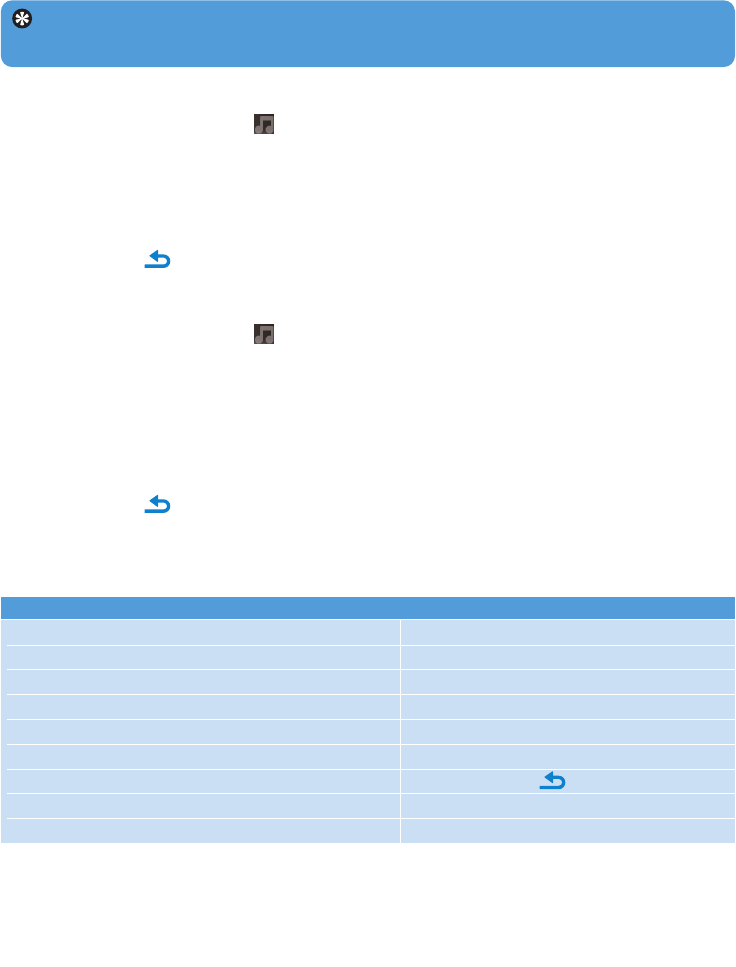
24
5.3 Listen to audio books
The player supports books in audio format. The use of this feature requires that you
download the plug-in software from audible.com. You can manage the digital content of your
audiobooks with the Windows Media Player 11.
Tip You can resume play after navigating away from audiobooks (see section Resume
play (Now playing) in this user manual).
5.3.1 Select audio book by book title
1From the main menu, select to enter music mode.
2Press 3or 4, then 2; to select Audiobooks.
3Press 3or 4, then 2; to select option Book titles.
4Press 3or 4to select title, then 2; to play.
5To exit, press .
5.3.2 Select audio book by author
1From the main menu, select to enter music mode.
2Press 3or 4, then 2; to select Audiobooks.
3Press 3or 4, then 2; to select option Authors.
4Press 3or 4, then 2; to select author.
5Press 3or 4to select title, then 2; to play.
6To exit, press .
5.3.3 Audiobook controls
The player offers the following audiobook mode controls:
Goal Action
Play / Pause Press 2;
Skip forward to beginning of new section/chapter Press 2
Skip back to beginning of current section/chapter Press 1
Fast skip forward through audiobook Press and hold 2
Fast skip back through audiobook Press and hold 1
Access options menu Press OPTIONS
Return to browsing menu Long/short press
Increase volume Press VOL +
Decrease volume Press VOL -

25
5.3.4 Adjust audiobook play speed
1In audiobook mode, press OPTIONS.
2Press 3or 4, then 2; to select Playback speed.
3Press 3or 4, then 2; to select Slower, Normal, or Faster.
4To exit, press .
5.3.5 Add a bookmark in an audiobook
1In audiobook mode, press OPTIONS.
2Press 3or 4, then 2; to select Bookmarks.
3Press 3or 4, then 2; to select Add bookmark.
> The display shows a confirmation screen.
4To exit, press .
5.3.6 Find a bookmark in an audiobook
1In audiobook mode, press OPTIONS.
2Press 3or 4, then 2; to select Bookmarks.
3Press 3or 4, then 2; to select Go to bookmark.
4Press 3or 4to select the bookmark in the list.
5Press 2; to go to the selected bookmark.
6To exit, press .
5.3.7 Delete a bookmark in an audiobook
1In audiobook mode, press OPTIONS.
2Press 3or 4, then 2; to select Bookmarks.
3Press 3or 4, then 2; to select Delete bookmark.
4Press 3or 4to select the bookmark in the list.
5Press 2; to delete the selected bookmark.
6To exit, press .

26
5.3.8 Delete an audiobook
1In audiobook mode, press OPTIONS.
2Press 3or 4, then 2; to select Delete audiobook.
3Press 2; to confirm the deletion of the current audiobook.
> The display shows a confirmation screen.
4To exit, press .
Tip
You can play and send audiobooks via Bluetooth (see section Play and transfer music,
videos, or audiobooks with Bluetooth in this user manual).
You can download audiobooks, magazines, and news in audio format at audible.com.
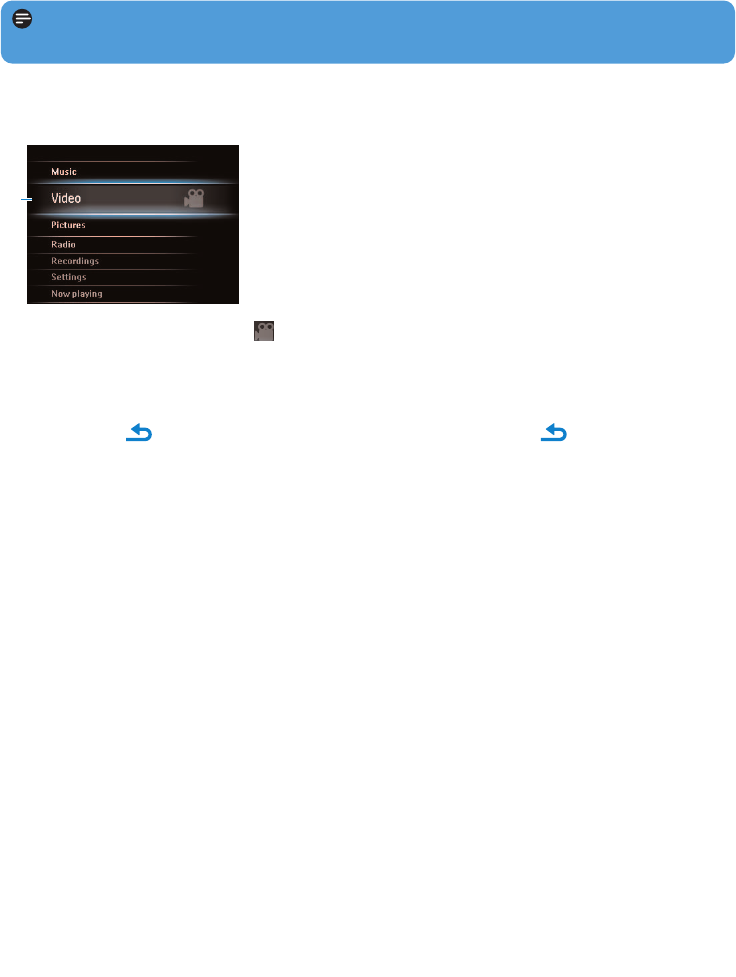
27
5.4 Video
5.4.1 Transfer videos from a computer to the player
Please see section Transfer videos in this user manual.
5.4.2 Video play
You can play video clips that are stored on the player.
1From the main menu, select to enter Video mode.
> A list of video files stored on the player is displayed.
2Press 3or 4to select the file and press 2; to play.
3Short press to go back to the previous menu, and long press to return to the
main menu.
5.4.3 Fast forward / backward control
The player enables you to scan videos in fast forward / backward mode.
Fast forward / backward
1Long press 2to select 4x normal speed.
> Press 2; anytime to resume normal speed play.
2While in 4x normal speed mode, press 2to cycle through the following speed options:
8x normal speed > 16x normal speed > 4x normal speed…
1
Note Videos that you have transferred through Rhapsody are available for play only in
the Rhapsody library.

28
5.5 Radio
From the main menu, select to enter radio mode.
Connect the headphones
The supplied headphones serve as a radio antenna. Ensure you connect the headphones
properly for an optimal reception.
5.5.1 Automatic tuning of radio stations
Note
The Autotune function saves the frequencies of found radio stations under presets and
overwrites existing presets.
When there are no frequencies saved under presets, the radio feature prompts you to
start Autotune.
Start a new Autotune session
1While in radio mode, press OPTIONS to see the options menu.
2Press 3or 4to select the Autotune, then 2; to start.
> The frequencies of found radio stations are saved to presets.
The radio can store up to 20 radio stations to presets.
5.5.2 Play a preset radio station
1While in radio mode, press OPTIONS to see the options menu.
2Press 3or 4to select the Select radio preset, then 2; to begin play.
3Press 1/2to change to another preset.
5.5.3 Manually tune a radio station
1While in radio mode, press 3or 4to manually tune to a radio station:
> To fine tune frequency, quick press 3/4.
To search for the next stronger signal, long press 3/4.
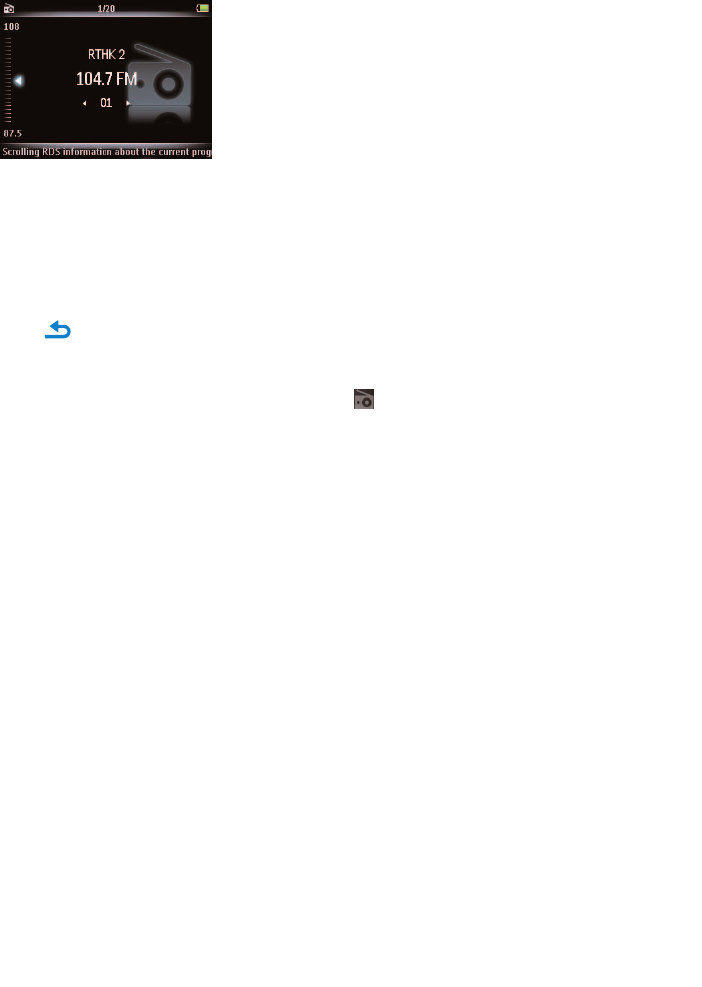
29
5.5.4 Manually save a radio station to a preset
1While playing a radio station, press OPTIONS to see the options menu.
2Press 3or 4to select the Save to preset, then 2; to save.
5.5.5 Record from FM radio when the radio is playing
1While in radio mode, press OPTIONS to see the options menu.
2Press 3or 4to select the Start radio recording, then 2; to start.
3Press 2; to pause.
4Press to stop and save the recording.
> Your recordings are saved in the Recordings library on the player.
5You can find you radio recordings files under > Recordings Library > Radio
recordings.
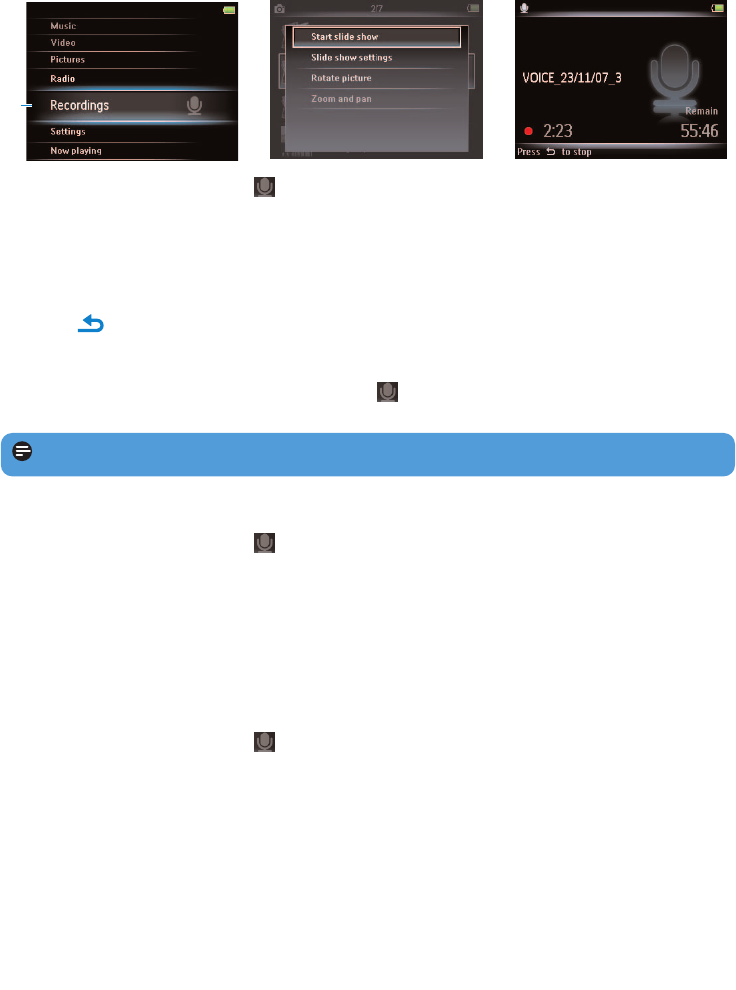
30
5.6 Recordings
You can record audio with the player. The section Overview of controls and
connections shows you the location of the microphone.
1From the main menu, select .
2While in recordings mode, press OPTIONS to see the options menu.
3Press 3or 4to select the Start voice recording, then 2; to start.
4Press 2; to pause.
5Press to stop and save the recording.
> Your recordings are saved in the Recordings library on the player.
6You can find the voice recordings file under > Recordings Library > Voice
recordings.
1
Note To record FM radio, see section Radio.
5.6.1 Play recordings
1From the main menu, select > Recordings Library > Voice recordings or Radio
recordings
2Press 3or 4to select the recording you want to hear.
3Press 2; to play.
5.6.2 Delete recordings
You can delete one or all of the recordings.
1From the main menu, select > Recordings Library > Voice recordings or Radio
recordings
2Press 3or 4to select the recording you want to delete.
3Press OPTIONS to see the options menu.
4Press 3or 4to select Delete or Delete all.
5Press 2; to confirm.

31
5.6.3 Upload recordings to the computer
1Connect the player to your computer.
2Select the player in Windows Explorer.
3Select Recordings > Voice or FM radio.
4Copy and paste the recordings to any desired location on the computer.
5.7 Use your player to store and carry data files
You can use your player to store and carry data files by copying data files into your player
with Windows Explorer.

32
6 Play and transfer music, videos, or
audiobooks with Bluetooth
You can stream music, videos, or audiobooks to other Bluetooth enabled output devices,
such as headphones or a car stereo system. You can also transfer music, videos, or
audiobooks to a Bluetooth enabled device, such as another player.
6.1 Play audio or video, or audiobooks on
another Bluetooth output device
You can choose to play either on a 'new device' or on an 'already paired device'. A new
device is a device that has not yet been paired with the player. A device that has been
previously paired with the player can be directly selected from the list. This chapter explains
the two different methods:
New Device:
1Ensure that the other Bluetooth device is turned on.
2Ensure that the other Bluetooth device is in pair mode.
3While playing music, video, or audiobook press OPTIONS.
4Press 3or 4and 2; to select the option Play via Bluetooth.
5Press 3or 4and 2; to select the output device.
6Press 3or 4and 2; to select New Device.
> The player searches and then displays the list of found devices.
7Select the device you want to connect to.
8Enter the passcode of the other device if necessary. (Consult the user manual of the
other device.)
> A confirmation message appears upon successful connection.

33
Already paired device:
1Ensure that the other Bluetooth device is turned on.
2Ensure that the other Bluetooth device is in pair mode.
3While playing music, video, or audiobook press OPTIONS.
4Press 3or 4and 2; to select the option Play via Bluetooth.
5Press 3or 4and 2; to select the output device.
6Select the device you want to connect to.
> A confirmation message appears upon successful connection.
6.2 Transfer files to and from another Bluetooth
device
You can choose to transfer either to a new device or to an already paired device. A
new device is a device that has not yet been paired with the player. A device that has been
previously paired with the player can be directly selected from the list. This chapter explains
the two different methods:
6.2.1 Transfer files from a list
New Device:
1Ensure that the other Bluetooth device is turned on.
2Ensure that the other Bluetooth device is in pair mode.
3While in a list, press 3or 4to mark the file you want to transfer.
4Press OPTIONS, to enter the options menu.
5Press 3or 4and 2; to select the option Send via Bluetooth.
6Press 3or 4and 2; to select the destination device.
7Press 3or 4and 2; to select New Device.
8The player searches and then displays the list of found devices.
9Select the device you want to transfer to.
10 Enter the passcode of the other device if necessary. (Consult the owner of the other
device, as this passcode can be customized.)
> A confirmation message appears upon successful transfer.

34
Already paired device:
1Ensure that the other Bluetooth device is turned on.
2Ensure that the other Bluetooth device is in pair mode.
3On the player, while in a list, press 3or 4to mark the file you want to transfer.
4Press OPTIONS, to enter the options menu.
5Press 3or 4and 2; to select the option Send via Bluetooth.
6Press 3or 4and 2; to select the destination device.
7Select the device you want to transfer to.
> A confirmation message appears upon successful transfer.
6.2.2 Transfer files while playing
New Device:
1Ensure that the other Bluetooth device is turned on.
2Ensure that the other Bluetooth device is in pair mode.
3On the player, while playing music, video, or audiobook press OPTIONS.
4Press 3or 4and 2; to select the option Send via Bluetooth.
5Press 3or 4and 2; to select the destination device.
6Press 3or 4and 2; to select New Device.
> The player searches and then displays the list of found devices.
7Select the device you want to transfer to.
8Enter the passcode of the other device if necessary. (Consult the owner of the other
device, as this passcode can be customized.)
> The play pauses during file transfer and resumes after the transfer is complete.
A confirmation message appears upon successful transfer.
Already paired device:
1Ensure that the other Bluetooth device is turned on.
2Ensure that the other Bluetooth device is in pair mode.
3On the player, while playing music, video, or audiobook press OPTIONS.
4Press 3or 4and 2; to select the option Send via Bluetooth.
5Press 3or 4and 2; to select the destination device.
6Select the device you want to transfer to.
> The play pauses during file transfer and resumes after the transfer is complete.
A confirmation message appears upon successful transfer.

35
6.2.3 Receive files
When another Bluetooth device sends a file to the player, you can accept or decline receipt
of the file.
1Press 3or 4and 2; to select Yes or No.
> You can find the file in the My Received files folder in the Folder view menu.
You can open the file upon receipt:
1Press 3or 4and 2; to select Yes.
> The player opens the file in the appropriate mode.
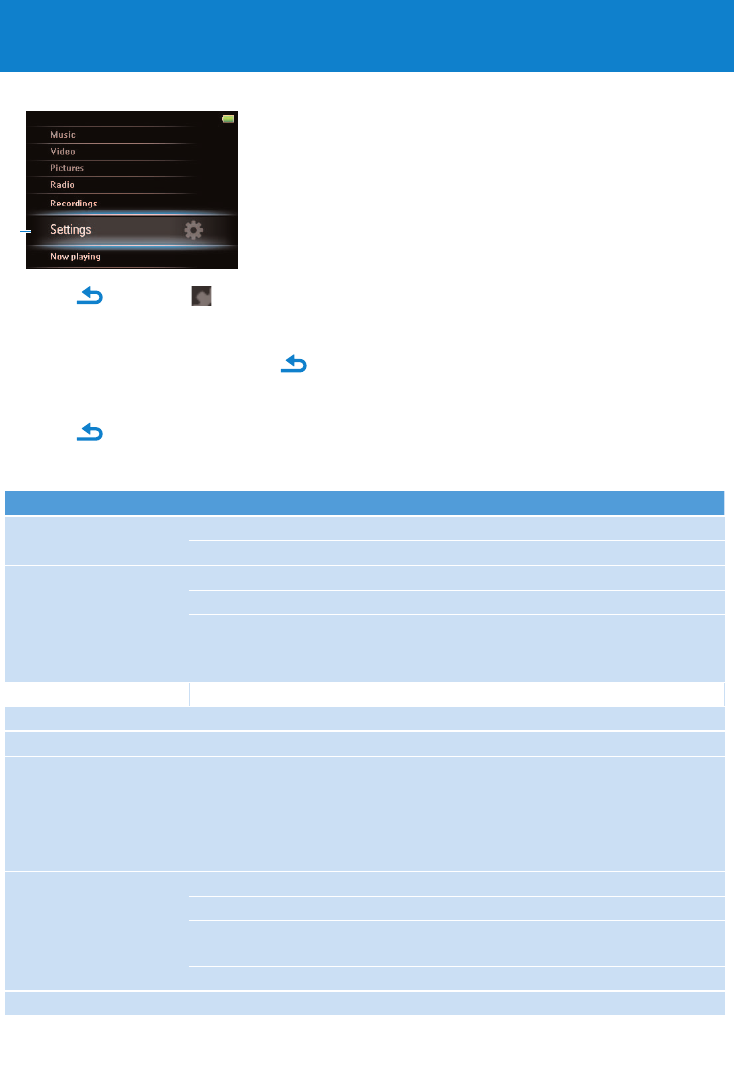
36
7 Settings
You can set preferences in your player to suit your needs.
1Press and select .
2Press 3or 4to select an option.
3Press 2; to go to next level or to return to previous level.
4 Press 2; to confirm your selection.
5Press to exit the Settings menu
In the Settings menu, the following options are available:
Settings Options Further Options
Play mode Shuffle all On / Off
Repeat Off / Repeat 1 / Repeat all
Sound settings Volume limite Off / Set
FullSound On / Off
Equalizer Off / Rock / Pop / Jazz / Classical / Dance /
Electronica / Lounge / RnB / Hip Hop /
Spoken Word / Custom
Backlight Always on / 10 seconds / 30 seconds / 60 seconds
Brightness slider (5 stages)
Sleep timer Off / 15 minutes / 30 minutes / 60 minutes
Language English (default) / French / German / Spanish / Italian / (Br)
Portuguese / Portuguese (European) / Dutch / Swedish / Norwegian
/ Finnish / Hungarian / Polish / Chinese Simplified / Chinese
Traditional / Japanese / Korean / Thai (for version /97 only) /
Turkish
Bluetooth Off / On
Connect to… New device / Paired device (list)
Show Device to
Others
Off / On
Device Information Device name / Device profiles
Rhapsody Rhapsody Account Information
1
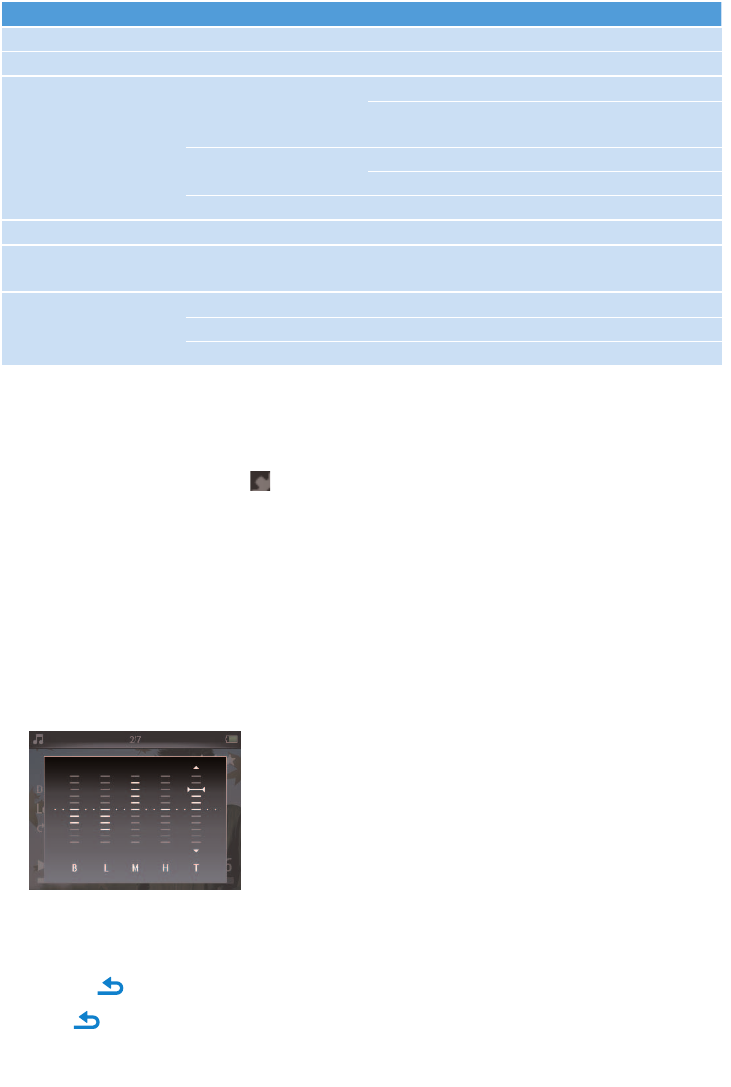
37
7.1 Equalizer custom settings
You can customize the equalizer settings:
11. From the main menu, select .
2While in settings mode, press OPTIONS to see the options menu.
3Press 3or 4, then 2; to select Sound settings.
4Press 3or 4, then 2; to select Equalizer.
5Press 3or 4, then 2; to select Custom.
6Press 1or 2to select equalizer band:
B= bass, L= low, M= mid, H= high, T= treble
7Press 3or 4to adjust level.
> Bar indicator shows current level.
8Press 2; to confirm your selection.
> Press to cancel the adjustments.
9Press to exit the Settings menu.
Settings Options Further Options
Demo Mode Off / On
Screensaver Off / On
Time and Date Time Settings Set time format 12 hrs / 24 hrs
Set time Hour / Minute /
AM/PM
Date Settings Set date format
Set date Day / Month / Year
Display in Header Off / On
Skins dark / Light / Red
Restore Factory
Settings
Confirm Confirmation feedback
Information Memory Capacity / Available free space
Firmware version
Support website

38
8 Update your player
Your player is controlled by an internal program called the firmware. Newer versions of the
firmware may have been released after you have purchased your player.
A software program called Philips Device Manager checks for firmware updates that are
available on the Internet.
Install Philips Device Manager from the supplied CD or download the latest version from
www.philips.com/support.
8.1 Perform a software update
Attention This procedure will erase the content of the player.
1Copy the content of the player to the computer as a back-up.
2Disconnect the player from the computer.
3Turn off your player.
4Ensure the computer is connected to the Internet.
5Click Start > Programs > Philips Digital Audio Player > SA52XX > Philips
SA52XX Device Manager to launch the Philips Device Manager.
6On the player, hold the volume "+" button while you connect the player to the
computer.
> The Device Manager enters recovery mode.
7Click OK to continue.
8When the display indicates that the process is finished, disconnect the player from the
computer.
> The display shows Updating firmware.
9Wait until the update process is completed on the player.
> The player restarts and is ready for use again.
10 Reconnect the player to the computer.
11 Transfer the back-up content to the player.

39
9 Technical data
Power
• Power supply
880mAh Li-polymer internal rechargeable
battery*
Display
• White backlight LCD, 320 x 240 pixels,
262K colors
Sound
• Channel separation: 45dB
• Equalizer setting:
Off / Rock / Pop / Jazz / Classical / Dance /
Electronica / Lounge / RnB / Hip Hop /
Spoken Word / Custom
• Frequency response: 20-18000Hz
• Signal to noise ratio: > 84dB
• Output Power (RMS): 2x3mW
Audio playback
• Compression format: MP3 (8-320kps and
VBR, Sample rates: 8, 11.025, 16, 22.050,
24, 32, 44.1, 48kHz), WMA (5-192kbps,
Sample rates: 8, 11.025, 16, 22.050, 24, 32,
44.1, 48kHz)
• Play time: 30 hours*
• ID3-tag support
Video playback
• .SMV format (other formats to be
supported by provided Media Converter)
• 30 frames per sec., 320 x 240 pixels
• Play time: 6 hours*
Media converter
• Support format:
.bmp, jpg, .wmv.
Recording
• Audio Capturing: Build-in microphone
(Mono)
• FM radio
Storage media
• Built-in memory capacity:
SA522x 2GB NAND Flash+
SA524x 4GB NAND Flash+
SA528x 8GB NAND Flash+
Connectivity
• Headphone 3.5mm, USB 2.0++
Music and picture transfer
• Via Rhapsody
Video transfer
• Via Philips Media Converter
Data transfer
• Via Windows Explorer
System requirements
• Windows® XP (SP2 or above), Vista
• Pentium III 800MHz processor or higher
• 128MB RAM
• 500MB hard disk space
• Internet connection
• Microsoft Internet Explorer 6.0 or later
• Video display card
• Sound card
• CD-ROM
• USB port

40
* Rechargeable batteries have a limited number of charge cycles. Battery life and number of
charge cycles vary by use and settings.
+ 1MB = 1 million bytes; available storage capacity will be less.
1GB = 1 billion bytes; available storage capacity will be less.
Full memory capacity may not be available as some memory will be reserved for the player.
Storage capacity based on 4 minutes per song and 64kbps WMA encoding.
++ Actual transfer speed may vary based on your operating system and software configuration.

41
My player cannot power on.
• You may have failed to press and hold 2; long enough. Press and hold 2; until the Philips
welcome screen appears on display.
• Your device battery may be out of power due to long period of non-usage. Please charge
your player.
If none of the above works, then you may have to use the Device Manager to
recover your player:
1Launch the Philips Device Manager at Start > Programs > Philips Digital Audio
Player > SA52XX > Philips SA52XX Device Manager on your PC.
2Press and hold the VOL+ button while your player is connecting to the PC.
3Keep holding the key until the Philips Device Manager acknowledges your player and
goes into recovery mode.
4Click the repair button and follow the instructions given by the Device Manager.
5After the player has been repaired, disconnect it from your PC and re-start.
There is no music on my player after transfer.
Are your songs in MP3, AAC or WMA format?
Other formats will not playback on the player.
There is no picture on my player after transfer.
Are your pictures in JPEG, BMP or GIF format?
Pictures in other formats cannot be transferred to your player.
There is no video on my player after transfer.
Make sure you use the media converter (provided in the CD Rom) to convert the video clips
into the readable format to the player.
10 Frequently asked questions
If you encounter problems with your player, go through the following points listed in the
next section. Please also check out FAQs at www.philips.com/support for further help and
other troubleshooting tips.
Consult your dealer or service center if you are unable to find a solution by following these
hints.
Warning Under no circumstances should you try to repair the set yourself, as this will
invalidate the warranty.

42
2If nothing happens, recharge the battery for at least 4 hours and try to power on or reset
again. If this does not work, you might have to repair your player with Philips Device
Manager.
There is no sound.
Make sure your headphones are inserted all the way into the headphones jack.
Some songs do not show up or playback on the player.
• The audio file might be corrupted, try to playback the file on your PC first. If it does not
play, rip the song again.
My player hangs.
1In the unlikely event that your player hangs, do not panic. Insert a small pin or other
sharp object into the reset hole located at the bottom of the player. Hold until the player
shuts down.
Note The existing contents on your player will not be erased.

43
PHILIPS reserves the right to make design and specification changes for product improvement
without prior notice.

Specifications are subject to change without notice.
Trademarks are the property of Koninklijke Philips
Electronics N.V. or their respective owners
© 2008 Koninklijke Philips Electronics N.V.
All rights reserved.
www.philips.com
Printed in China
wk8083
abc
Page
67
Philips Consumer Electronics Company Digital Audio Player FCC ID:BOUSA5225BT
IC ID :135M-SA5225BT
NOTE: THE MANUFACTURER IS NOT RESPONSIBLE FOR ANY RADIO OR TV
INTERFERENCE CAUSED BY UNAUTHORIZED MODIFICATIONS TO THIS
EQUIPMENT. SUCH MODIFICATIONS COULD VOID THE USER’S
AUTHORITY TO OPERATE THE EQUIPMENT.
